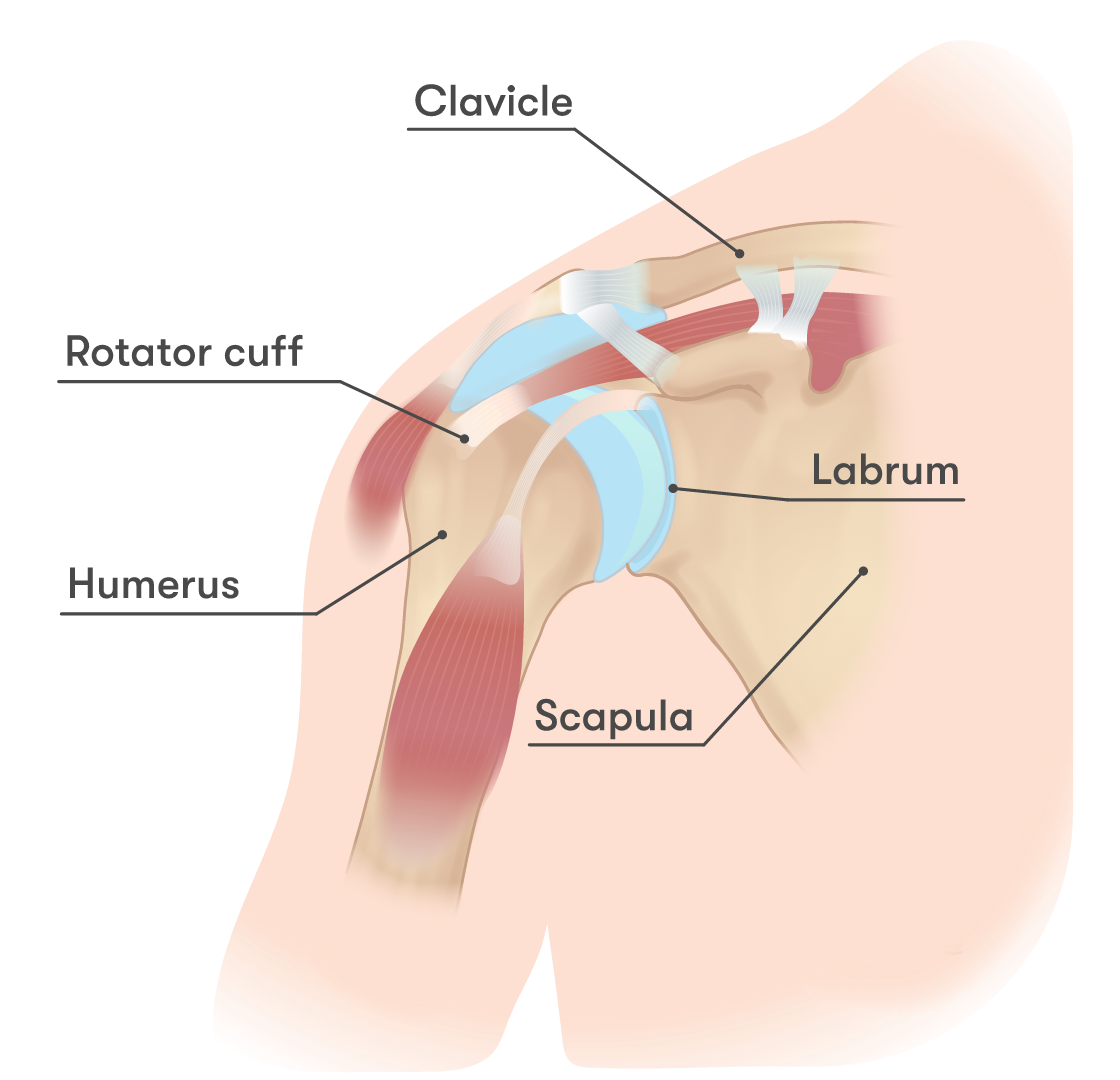Content:
What is a shoulder impingement?
Exercises for shoulder impingement
Symptoms
Causes
Treatment options
Do I need surgery for shoulder impingement?
Recovery time
When to see a doctor about your shoulder pain
Treating shoulder pain with shoulder impingement exercises
Can’t reach behind to scratch that itch on your back? Do you feel a sharp pain in your shoulder, when you reach for something on an upper shelf? Does your shoulder feel weak in the gym and are you unable to lift as heavy as before? If any of these symptoms sound familiar, you could be suffering from shoulder impingement syndrome. It is a common condition that occurs due to injury to the bones and muscles of your shoulder. Luckily, most people improve with shoulder impingement exercises and conservative home remedies.
In this informative guide, we explore the common causes, symptoms, and treatments for shoulder impingement. We also share some effective stretching and strengthening exercises to speed up your recovery. The Injurymap app demonstrates a range of shoulder exercises to guide you through your home rehab. You can do these exercises at your convenience with little to no equipment.
Looking for a solution to shoulder impingement? Try the Injurymap exercise app now.
What is a shoulder impingement?
The shoulder is one of the most mobile joints in the human body. We use our shoulders to move our arms.The shoulders have a tremendous range of motion. Not surprisingly, any injury to the structures in the shoulder leads to pain and limitation of movement.
Shoulder impingement refers to a painful pinching of the soft tissues of the shoulder. It is a common condition that occurs as a result of injury to the bones and muscles of the shoulder. It frequently affects active adults, especially older individuals.1
Shoulder impingement often occurs in combination with other painful shoulder conditions such as rotator cuff tendinitis and shoulder bursitis. Tendinitis is an inflammation of the tendons of the rotator cuff (tendons connect muscle to bone). Bursitis is an inflammation of a shoulder bursa, a fluid-filled sac that reduces friction.
Some people have an unusually shaped acromion (the bony tip of your shoulder) or a narrow subacromial space (a natural space below the acromion). This type of anatomy can either be inherited or occur as a result of arthritis.
Bone spurs (bony projections) into the subacromial space make it narrow. The presence of these anatomical variations increases your risk of developing shoulder impingement.3,4 Last but not least, poor posture, such as slumping or hunching, can irritate the rotator cuff and cause shoulder impingement symptoms.
Treatment options
There are many effective treatments available for shoulder impingement, including home physical therapy exercises. Because shoulder impingement is typically caused by overuse injury, rest is an important part of recovery. However, it is important to stretch and strengthen the joint with gentle shoulder impingement exercises to avoid further joint stiffness. Some of the treatment options for shoulder impingement include:3
Medications: Over-the-counter nonsteroidal anti-inflammatory drugs (NSAIDs) like ibuprofen and acetaminophen can help reduce swelling and pain. For more severe shoulder pain, your doctor may prescribe steroid injections to reduce inflammation in the injured tissues.
Icing: Placing an ice pack on your shoulder for 10-15 minutes several times a day can help decrease shoulder pain and swelling.
Regenerative medicine: There are some experimental treatments for shoulder pain, such as PRP (platelet-rich plasma) therapy and stem cell injections. However, there is very little clinical evidence to support the effectiveness of these treatments. Experts recommend physical therapy as the fundamental shoulder impingement treatment.4
Do I need surgery for shoulder impingement?
Your doctors will decide whether you need surgery for shoulder impingement. Luckily, most people with shoulder impingement heal without surgery. However, if conservative measures like physical therapy and medications do not adequately relieve your shoulder pain and restore your range of motion, your doctor may recommend surgery for shoulder impingement.
The goal of shoulder impingement surgery is to create room for soft tissues that are getting pinched and squeezed in the shoulder area. Widening the space around the rotator cuff muscles allow them to move freely without rubbing against bone.
Surgeons achieve this by removing bone from under the acromion (the bony tip of your shoulder) or removing an inflamed shoulder bursa (a bursa is a fluid-filled sac in the joint that reduces friction). If you have a tear in your rotator cuff muscles, the surgeon may recommend repairing it and reattaching the torn tendons.4
Recovery time
Once you develop shoulder impingement, it can take 3 to 6 months to heal and become pain-free. If your shoulder injury is more severe, the recovery time for shoulder impingement can be up to one year.3 However, most people can begin normal activities within 2-4 weeks. The best way to speed up recovery is to participate in a regular stretching and strengthening program with shoulder impingement exercises.
What happens if shoulder impingement is left untreated?
If left untreated, shoulder impingement can lead to serious complications like a rotator cuff tear which may require surgical treatment.5 Other complications of untreated shoulder impingement include adhesive capsulitis (frozen shoulder), cuff tear arthropathy (degeneration of the rotator cuff), and reflex sympathetic dystrophy (long-lasting pain and swelling in the upper limb).6
How to prevent shoulder impingement in the future
You can reduce your risk of developing shoulder impingement in the future by:
- Stretching the muscles of your shoulders, neck, arms, and chest
- Building strength in your shoulder muscles
- Maintaining a good posture (avoid sitting hunched over at a desk or computer for long periods)
- Practicing the proper technique for overhead and throwing motions during sports
When to see a doctor about your shoulder pain
Call emergency medical assistance if you are experiencing shoulder pain along with chest tightness and difficulty breathing as this could be a symptom of a heart attack.
Most people with shoulder impingement get better with home remedies, including rest, ice, pain relievers, and physical therapy exercises. However, you should schedule a visit to your doctor’s office if your symptoms include swelling, redness, warmth, or tenderness around the shoulder joint along with shoulder pain. You should seek immediate medical attention if you have any of the following signs and symptoms accompanying your shoulder pain:7
- Your shoulder joint appears visibly deformed (out of shape compared to the other side)
- You cannot move your arm or use your shoulder joint
- You have severe, unrelenting pain that does not go away with medication
- You develop sudden swelling in the shoulder area
Treating shoulder pain with shoulder impingement exercises
Shoulder impingement is a common condition that can put the brakes on the active lifestyle you love. Pain, stiffness, and restricted movements can make it difficult or even impossible to do your activities of daily living. But you don’t have to live with shoulder impingement symptoms. Physical therapy rehab is an effective treatment for most people with shoulder impingement. Exercise can help you return to full shoulder function and pain-free activities.
The Injurymap app demonstrates a range of stretching and strengthening exercises for your shoulders, neck, arms, and chest. You can work out the muscles that are directly responsible for shoulder movements as well as the muscles that support the functioning of this complex joint. Regularly exercising your shoulder muscles will not only improve your shoulder impingement symptoms but also protect you from future shoulder injuries.
All exercises in the Injurymap app can be conveniently performed at home with minimal equipment. The app shows you the correct posture, form, and technique to do each exercise. It’s easy to do shoulder impingement exercises with clear verbal instructions and videos. Don’t let shoulder impingement prevent you from doing the things you love – start using the Injurymap app today.
Begin your 14-day free trial of the Injurymap app today!



